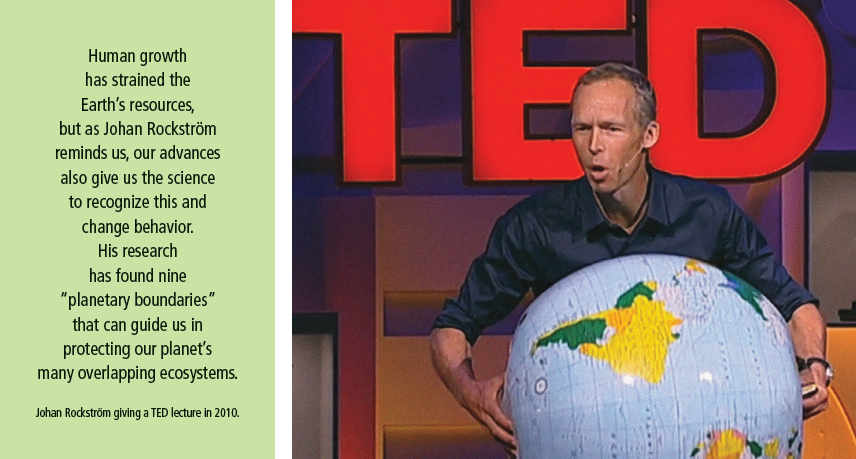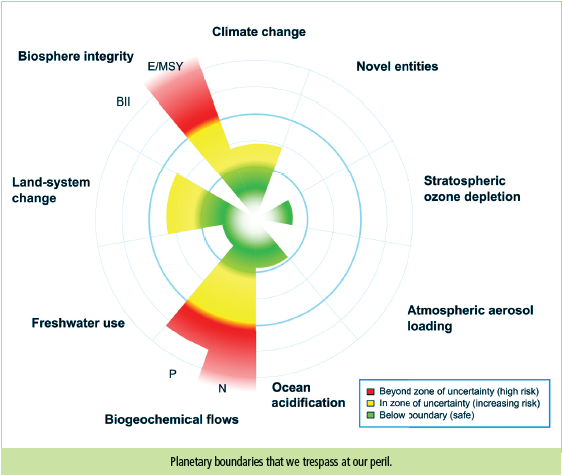Going Boldly—and Recklessly— Where No Man Has Gone Before: Trespassing Planetary Boundaries
Published on July 3rd, 2015
PDF Download: caps_issues_trespassing_planetary_boundaries_july_2015.pdf

July 2015
For several decades earth scientists and ecologists have warned that humanity was fast approaching the Earth’s limits to growth. And during these same decades humanity has thumbed its collective nose at these same scientists, either ignoring them altogether, or deriding them as sticks in the mud, killjoys, misanthropes, party poopers, spoilsports, anti-growthers, tree huggers, Luddites, doomsters or doomsayers (take your pick).
Now comes Johan Rockström, executive director of the Stockholm Resilience Centre in Sweden. Rockström and his international team of scientists have developed a list of “planetary boundaries” that human civilization must not transgress if we are going to be good tenants—and stewards—of Planet Earth.
While Rockström claims to be an optimist, believing that both the Earth and its dominant species—at the moment a certain bipedal ape—are resilient and adaptable, he says that, nevertheless: “For the first time ever, we might shift the planet from friend to foe.”
The planetary boundaries framework was first introduced in 2009, when a team of 28 prominent scientists identified and quantified the first set of nine planetary boundaries within which humanity could continue to develop and flourish for many years to come. In contrast, crossing these boundaries could potentially entail adverse, abrupt or irreversible environmental changes. Respecting the boundaries reduces the risks to human civilization of crossing these thresholds.
Table 1 on page 2 lists and describes these boundaries. You can watch the video at http://www.ted.com/talks/johan_rockstrom_let_the_environment_guide_our_development?language=en.

 In a January 2015 paper in the prestigious journal Science, Rockström and colleagues now argue that humanity has already blown past four of the nine boundaries keeping our planet hospitable to modern life—human and nonhuman alike. We have already trespassed into forbidden territory when it comes to climate change, extinction of species, addition of phosphorus and nitrogen to the world’s ecosystems, and deforestation.
In a January 2015 paper in the prestigious journal Science, Rockström and colleagues now argue that humanity has already blown past four of the nine boundaries keeping our planet hospitable to modern life—human and nonhuman alike. We have already trespassed into forbidden territory when it comes to climate change, extinction of species, addition of phosphorus and nitrogen to the world’s ecosystems, and deforestation.
It is urgent that we retreat back to within the safety zone, or “safe operating space.” The longer we are outside it, we and the biosphere are exposed, and the more we risk incurring the wrath of forces that may spin out of control. To cite just one example, by releasing trillions of tons of greenhouse gases into the atmosphere since the dawn of the industrial age, raising the concentration of carbon dioxide to levels it hasn’t been at for hundreds of thousands of years, and rapidly boosting average global atmospheric temperatures, man may have already unwittingly lit the fuse of the “methane bomb” in the Arctic.
 The Arctic is warming at double the rate of the planet as a whole, and vast deposits of methane hydrates in permafrost and on the sea floor are becoming destabilized. Were these molecules to break down en masse, the resulting surge of methane (CH4)—a far more potent greenhouse gas than CO2—into the atmosphere could be catastrophic. Systems scientists refer to this as a “positive feedback loop,” wherein a given degree of warming trips a trigger or tipping point, leading to still more warming, and a possible runaway greenhouse effect. Recent research by geologists suggests that similar methane surges in the geologic past may be implicated in at least some of the Earth’s mass extinction events over the past 450 million years.
The Arctic is warming at double the rate of the planet as a whole, and vast deposits of methane hydrates in permafrost and on the sea floor are becoming destabilized. Were these molecules to break down en masse, the resulting surge of methane (CH4)—a far more potent greenhouse gas than CO2—into the atmosphere could be catastrophic. Systems scientists refer to this as a “positive feedback loop,” wherein a given degree of warming trips a trigger or tipping point, leading to still more warming, and a possible runaway greenhouse effect. Recent research by geologists suggests that similar methane surges in the geologic past may be implicated in at least some of the Earth’s mass extinction events over the past 450 million years.
The January 2015 Science paper calls attention to the remarkable climatic stability of the Holocene Epoch, which began when the last Ice Age ended 11,000 years ago, and has continued to the present day. The Holocene has nurtured the emergence and expansion of civilization. This period of comparative planetary tranquility encouraged our ancient ancestors to wander away from the security of their Paleolithic and Pleistocene caves and eventually to cultivate wheat and other grains, and domesticate wild animals such as wolves and sheep, launching first the agricultural and later the industrial and communications revolutions.
 As a result, the world’s population grew faster and then exponentially, now reaching 7.3 billion, with a billion more being added every 12 years. As human settlements and civilizations developed and then enveloped the Earth, in the blink of a geologic eye humans have transformed the most productive landscapes in the world. We have cut down forests, replacing them with monoculture crops grown on an industrial scale; our livestock have overgrazed grasslands and degraded marginal zones into virtual deserts. We’ve created air, water, noise and toxic pollution, and driven an ever-growing number of plants and animal species to the brink of extinction…and over that brink into permanent oblivion.
As a result, the world’s population grew faster and then exponentially, now reaching 7.3 billion, with a billion more being added every 12 years. As human settlements and civilizations developed and then enveloped the Earth, in the blink of a geologic eye humans have transformed the most productive landscapes in the world. We have cut down forests, replacing them with monoculture crops grown on an industrial scale; our livestock have overgrazed grasslands and degraded marginal zones into virtual deserts. We’ve created air, water, noise and toxic pollution, and driven an ever-growing number of plants and animal species to the brink of extinction…and over that brink into permanent oblivion.
Yet despite all these abuses, our planet has kept circling the sun and kept spinning around, as it has for billions of years, continuing to support us, with the biosphere or ecosphere more or less stable and in balance. Going forward, the planetary boundary scientists write that there is an “urgent need for a new paradigm that integrates the continued development of human societies and the maintenance of the Earth system in a resilient and accommodating state.”
Perhaps the best way to grasp the import of planetary boundaries is to think in terms of “Spaceship Earth,” the metaphor first used in 1879 by the American writer Henry George (1839-1897). In George’s best-known book, Progress and Poverty, he wrote:
“It is a well-provisioned ship, this on which we sail through space. If the bread and beef above decks seem to grow scarce, we but open a hatch and there is a new supply, of which before we never dreamed.”
In 1965, just as the modern environmental movement was being born, American politician and diplomat Adlai Stevenson II (1900-1965) popularized the term “Spaceship Earth” in a famous speech he made to the United Nations:
“We travel together, passengers on a little space ship, dependent on its vulnerable reserves of air and soil; all committed for our safety to its security and peace; preserved from annihilation only by the care, the work, and, I will say, the love we give our fragile craft.”
 Even today, many people, and unfortunately many powerful people, instinctively recoil at and reflexively reject any notion of boundaries or limits on Earth itself. It is far easier to accept them when we think in terms of an actual spaceship—say the International Space Station (ISS).
Even today, many people, and unfortunately many powerful people, instinctively recoil at and reflexively reject any notion of boundaries or limits on Earth itself. It is far easier to accept them when we think in terms of an actual spaceship—say the International Space Station (ISS).
My niece is an aeronautical engineer who works for NASA at the Mission Control Center in Houston. Specifically she is responsible for power systems on the ISS. At any given time there are about six astronauts aboard the ISS; I doubt she would tell me it’s possible for these power systems to support 12 or 24 astronauts instead of six for any considerable length of time, to say nothing of infinite growth in the number of astronauts on the ISS.
If we want Planet Earth to continue to be our friend and not our foe, it’s high time we acted more like a friend ourselves. Converting our only home in the universe from a paradise into a wasteland is neither a friendly nor an intelligent act, one far beneath the purported potential of a being that had the audacity to name himself Homo sapiens (Latin for “wise man”).
CAPS Senior Writing Fellow Leon Kolankiewicz is an environmental scientist and planner.




